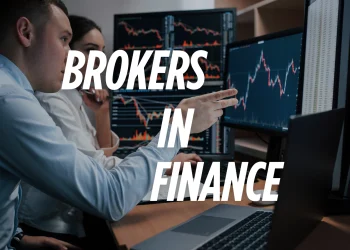When compared with other financial instruments, forex trading attracts a lot of traders since you can usually acquire much larger leverage than you could with stocks. Although a lot of traders have become aware of the term “leverage,” few are familiar with what it means, how it operates, and how it can negatively affect their capital. This article will help you avoid all that and be aware of all the pros and cons that come with leverage.
What is Leverage in Forex?
Forex traders can borrow capital to increase their exposure to the Forex market by using leverage. They can manage a higher trading size with less amount of capital. Due to the fact that they depend on the whole value of the position, this could result in greater returns and losses.
Leveraged forex trading, also known as forex margin, allows you to increase earnings if the market moves in your favor but also exposes you to the risk of total loss if the market turns against you. This is because both earnings and loss are calculated based on the total value of the trade, rather than just the deposit amount.
How Does Leverage Work?
Leverage in the forex market is frequently as great as 100:1. This implies that you may exchange up to $100,000 in value with every single $1,000 in your account. Many traders think that since leverage is an aspect of risk, that is why forex market makers give such high leverage. They would not be offering the leverage unless they were confident that the account would be properly managed and that the risk would also be highly controllable. Additionally, because of the size and liquidity of the forex markets, it is considerably simpler to enter and exit trades at the level of your preference than it is in other less liquid markets.
Pips, the smallest change in currency price and a unit used in trading are what we use to track currency changes. In reality, these changes only amount to a few cents. For instance, the exchange rate only changes by 1 cent when the GBP/USD currency pair goes from 1.9500 to 1.9600, or 100 pips.
Because of this, significant sums of capital must be exchanged for small price changes to be converted into larger returns and then compounded by leverage. When dealing with a quantity like $100,000, slight fluctuations in the exchange rate can have a big impact on your earnings or losses.
What is Margin?
The overall amount of capital required to open a leveraged trade is known as the margin. When trading on margin, your deposit is only required to be a portion of the position’s total value. The starting rate for a margin is 3.3% for the most popular currency pairs, such as EUR/USD, USD/JPY, and GBP/USD, though this might vary between brokers.
Any deposits made to maintain open positions are kept by the broker and are known as “used margins.” Available equity, or “margin level” when represented as a percentage, is any capital that is available to open more positions.
A margin call happens once your margin level falls below a predetermined threshold, putting your positions in potential danger of being liquidated. Margin calls need to be avoided because they lock in a trader’s losses, therefore it’s important to keep an eye on the level of margin. The possibility of margin calls can also be decreased by using risk management strategies.
The Risks That Come With Leverage in Forex

The problem with leverage is that it can either increase your returns or decrease them by an equal amount. The risk you take on increases with the amount of leverage you apply to your capital. However, if a trader is not careful, it may have an impact on their success on trades. It should be acknowledged that this risk is not always tied to margin-based leverage.
Let’s use an example to demonstrate this idea. There are two traders, they are both dealing with a broker who requires a 1% margin deposit, and they each have a trading capital of US$10,000. Both of them think that USD/JPY is reaching a high and should decline in value after performing some studies. They both short the USD/JPY at 120 as a result of it.
Based on their $10,000 trading capital, Trader A decides to use 50 times real leverage on the trade by shorting US$500,000 worth of USD/JPY. Due to the current USD/JPY exchange rate of 120, one pip of USD/JPY is equivalent to about $8.30 for one standard lot and approximately $41.50 for five standard lots. Trader A will experience a loss of 100 pip, or $4,150, on this trade if the USD/JPY rises to 121. One loss will account for a staggering 41.5% of their trading capital.
Being a more cautious trader than Trader A, Trader B chooses to use five times real leverage on this transaction by shorting US$50,000 worth of USD/JPY with a trading capital of $10,000. The USD/JPY amount of $50,000 is only equivalent to half of one regular lot. Trader B will have a loss of $415 or 100 pip on this trade if USD/JPY increases to 121. As a result, 4.15% of their whole trading capital is accounted for by this one loss.
How to Avoid Leverage Risks
Leverage trading might be thought of as a technique to boost your forex gains, but it also increases your risk exposure. As a result, using leverage in the forex market requires having a strong risk management plan in place. The following are some risk management procedures you can use to lower the risks that accompany leverage trading.
Stop Losses
With a stop-loss order, you can exit a trade if it shifts against you at a predetermined price, limiting your losses in a bearish market. In general, you are specifying the amount of risk you are willing to accept for the trade. Even with a stop-loss in place, slippage makes it impossible to guarantee the close-out price.
Like a standard stop-loss, a trailing stop-loss operates similarly. However, the trailing stop-loss follows the market’s movement when it goes in your favor, hoping to capture any upward price movement.
No matter what the market volatility or gap is, a guaranteed stop-loss order (GSLO) will be filled at the specific price you choose. On delivery of your order, you must pay a premium for this advantage. This premium is indicated on the purchased ticket. Fortunately, if the GSLO is not triggered, the payment is given back.
Take Profits
Take-profit orders function similarly to limit orders in the sense that they are always filled at the target price you select. Any positive slippage will be passed along to the buyer if the market opens at a more favorable price than your target price.
Conclusion
Once you understand how to manage leverage, there is no reason to be afraid of it. Leverage shouldn’t ever be employed if you let your transactions run on their own without your supervision. Otherwise, with correct management, leverage can be used effectively and productively.
Applying less real leverage to each trade allows for broader but realistic stops and lower capital losses, giving traders more breathing room. If a highly leveraged trade goes wrong, it can quickly wipe out your trading account because you will suffer greater losses because of the larger lot sizes. Remember that leverage is completely flexible and may be adjusted to meet the needs of any trader.












